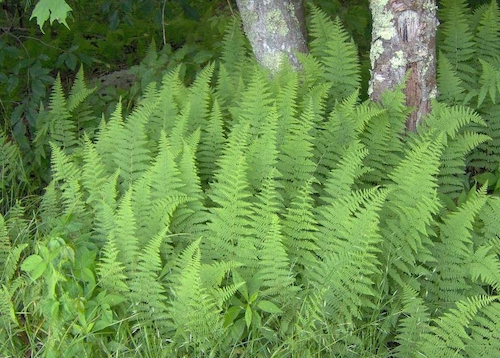The 360 on Hay-Scented Ferns
by Janet Scheren, Fairfax Master Gardener
I’ve long been aware of the native fern growing in the woods behind our house that blankets the ground beginning in late spring. Unlike other ferns that grow there — the Christmas fern, Cinnamon Fern, Lady Fern and others — this fern grows individual fronds that shoot up from an underground stem, called a rhizome. This sets them apart from ferns that form clumps.

Hay-scented fern
Last year, the arborist at our local garden center told me that he uses hay-scented ferns as a ground cover near his patio. He said it was his wife’s favorite plant. It turns out that this useful groundcover is the same fern covering wide expanses of our neighborhood’s forest floor. It’s called hay-scented fern because when stepped on or crushed it emits the smell of fresh mowed hay.
Hay-scented ferns (Dennstaedtia punctilobula) form dense mats of roots that allow it to carpet wide swaths of the forest floor and outcompete other plants and seedlings. Hay-scented fern is deciduous and can grow up to 2 feet (60 cm) in height and spread up to 3 to 4 feet (90 – 120 cm) wide. When it emerges in spring, it’s lush bright green. It’s often considered ephemeral, though, as it turns soft yellow and tends to look raged as it moves into fall.
This fern grows in colonies, and a surprising benefit is that it naturally repels deer. It is great to use in creating a border around a garden bed, for groundcover or to naturalize a garden. Hay-scented fern is indigenous to USDA climate zones 3 to 8. It grows from Newfoundland to Alabama, but it is more abundant in the eastern states. It grows freely on the floors of forests, creating a green luxurious carpet. It can also be found in meadows, fields and rocky slopes.
It’s fairly easy to grow hay-scented ferns because they are hardy and establish quickly. Their main requirement is good drainage. If your soil is poor, it’s worth it to add some compost for extra enrichment. Because these ferns grow rapidly and spread quickly, you will want to plant them about 18 inches (45 cm) apart. They prefer partial shade with slightly acidic soil. They can be grown in full sun, but they won’t look as lush. This fern is invasive, which makes it excellent as a groundcover. However, you will not want to plant this fern around weaker plants.
The Dark Side
You should also keep in mind that hay-scented fern quite literally has a dark side to it. It has a dense understory, which essentially creates a biological desert below. This limits plant and wildlife diversity around them and provides little food or cover for wildlife. While they don’t emit any plant-generated chemicals (allelopathy) that limit the growth of other plants, these ferns alter the quality and quality of light close to the ground or forest floor.

Hay-scented fern leaf
This is an interesting phenomenon for all gardeners to consider. Light from the sun travels past shade casting objects, but the closer to the ground the object is, the denser the shade it cases. This is why shade from high tree canopies typically creates a bright shade. This is why you can limb up trees to create more light in an area without removing the tree. You just lift the height of the tree canopy. The lower limbs create denser shade than the high canopy. Because the fern canopies are close to the ground with little space between them, they cast a really dense shadow.
This might be a benefit in a contained garden bed, but it can be a significant problem in forest regeneration. U.S. Forest Service studies found that growth of desirable seedlings, such as black cherry, sugar maple and red maple, is severely stunted when hay-scented and other bracken ferns densely cover the ground. Their report indicates that seedling growth and development is reduced by about 90 percent. That means that you get only 10 percent of the seedlings that would normally grow there. Black birch, blackberry, black raspberry and pin cherry seem to establish despite this affect. Take this into account if you plan to plant seeds or seedlings among hay-scented ferns.
Resources
Dennstaedtia punctilobula, Extension Gardener Plant Toolbox, North Carolina State Extension
Eastern Hay-Scented & New York Fern, Mountain Lake Biological Station, University of Virginia
Controlling Understory Fern Competition for Regeneration Success, David R. Jackson and James Finley, Penn State Extension